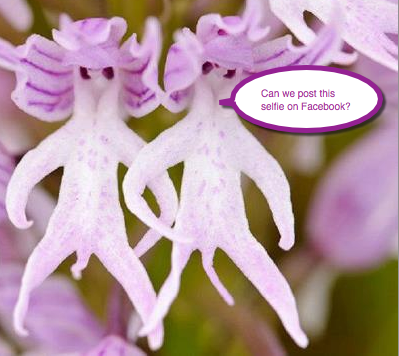
by Lorraine Brodek | May 28, 2014 | Blog
There is no singular word in Hawaiian for the physical universe, so obviously nature takes on many forms, shapes and sizes in Hawaii–not to mention humor. My friend, Jil, asked me not to show any more poop pictures and instead asked to see some flowers in our Maui garden.  Since I’m thrilled to have one friend who actually reads my stuff, I’m more than happy to oblige. So I opened up some of my iPhoto albums and, of course, the first flowers that caught my eye were orchids. Did you know that there are about 35,000 species of orchids in the world?! How many people did it take to count those things? I know for sure that we have a bunch of ’em at our house including some Cattleya and Phalaenopsis shown at right.
Since I’m thrilled to have one friend who actually reads my stuff, I’m more than happy to oblige. So I opened up some of my iPhoto albums and, of course, the first flowers that caught my eye were orchids. Did you know that there are about 35,000 species of orchids in the world?! How many people did it take to count those things? I know for sure that we have a bunch of ’em at our house including some Cattleya and Phalaenopsis shown at right.
Orchids do not grow in soil. They grow in the air by attaching their roots to hard surfaces that get washed by the rain. We have orchids growing on our lava walls, hanging out of our trees and everyone needs an orchid by their outhouse.  But here I am talking about poop again. I immediately emailed an orchid pic to Jil and lo and behold, it got her husband, George, all excited. He had just seen two amazing orchids on the internet and said I had to have them. He forwarded the photos my way and I couldn’t believe what I was seeing. I think they originate from Equador or Peru or somewhere down in those naked jungles, but I certainly believe they would be most happy growing on Maui. Of course, to get them here, we’d have to deal with the USDA, the IPPC, NAPPO, PHQG, the APHIS and PPQ programs, not to mention the EPA and the TSA. So perhaps a few pictures would do just as well.
But here I am talking about poop again. I immediately emailed an orchid pic to Jil and lo and behold, it got her husband, George, all excited. He had just seen two amazing orchids on the internet and said I had to have them. He forwarded the photos my way and I couldn’t believe what I was seeing. I think they originate from Equador or Peru or somewhere down in those naked jungles, but I certainly believe they would be most happy growing on Maui. Of course, to get them here, we’d have to deal with the USDA, the IPPC, NAPPO, PHQG, the APHIS and PPQ programs, not to mention the EPA and the TSA. So perhaps a few pictures would do just as well.
Photos #1 and #2 in this series show “The Hanging Naked Man Orchid.” I think a much better name would be “The Anthony Gigantea Weiner Orchid:”

#3 in the series is called the Monkey Orchid or Orchis Simia. My suggestion for a more fun name would be: “The Donald Trumpus Follicus Orchid.” 
No blow-dry necessary and it’s naturally orange/blond. Arena flowers.com says it smells like ripe orange when it matures. That would match the hair. How great is that?
So now this whole flower and humor in the garden thing has got me going and I have just dug up a few more pictures from the file. Another phallic-type flower that we have in multiple sizes and colors under the palms and ferns is the Anthurium. It is also called the “Boy Flower.” No explanation necessary:


Hawaiians have this joke going around that I thought I should warn you about so you are prepared for the question. Here it is: How do you tell the difference between a male and female Plumeria tree? This question can also apply to any tree like a Mango or Guava for example. Here is the answer: the picture on your left is the female and the one on the right is the male:

Some Hawaiian fisherman hang their buoy balls in trees. What are buoy balls? Well..they’re really fish net floats that keep the huge expanse of fishing nets afloat in the ocean. They used to be handmade of glass by glassblowers using old Sake bottles, but are now made of plastic or aluminum. Appropriately, there are two balls in the male tree above.
Since I seem to be focusing on the male of the species in plant life as we know it..I do have one photo that shows a female lime having a mammogram.  She had grown naturally between these two branches. Poor thing I rescued her just in time. And she thanked me by blessing my Mai Tai that night:
She had grown naturally between these two branches. Poor thing I rescued her just in time. And she thanked me by blessing my Mai Tai that night:
I shall now end this horticulture lesson with my thought for the day: Flowers bring beauty and fragrance to the outhouse of life:

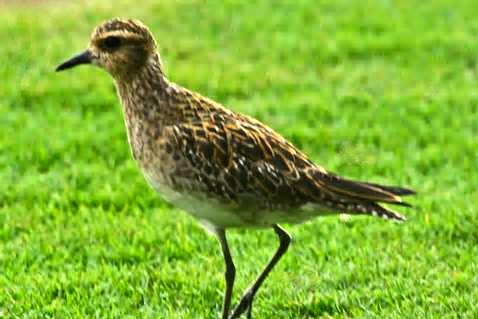
by Lorraine Brodek | May 21, 2014 | Blog
We named her Katie (Keke in Hawaiian). Kolea is Hawaiian for golden plover. It’s botanical name is Pluvialis fulva which sounds like an organ  from which a gynecologist might take a pap smear. Or..in the case of the male..it could be the title of the next spy flick: Agent 007–The Man with the Golden Plover. Appropriately..a plover is a bird.
from which a gynecologist might take a pap smear. Or..in the case of the male..it could be the title of the next spy flick: Agent 007–The Man with the Golden Plover. Appropriately..a plover is a bird.
And a rather amazing bird at that. “Our” tougher plover just left us for its winter home. If you want a lesson in perseverance, endurance, risk-taking and all-around spunk–this is the bird to teach you that. Katie arrived on our lawn last year in August. We weren’t able to pinpoint the exact date because we were “off-island” then, but we do know that our plover departed three weeks ago on April 26th.
And “Where for art thou flying?” you might ask this feathery little shorebird. Well..all the way back to the western shores of Alaska from the Hawaiian  Islands–50 non-stop hours going about 50 mph at 20,000 feet with wings flapping (about two wing-beats per second) over 2,500 miles of open ocean! No coasting, no soaring, no gliding. And if you think that’s bad, koleas can’t swim! Ornithologist, Dr. Oscar “Wally” Johnson, put it this way, “Imagine that flight you made from L.A. to Honolulu–only without a plane.” And we complain because we’re in the back of coach and airlines seem to be slowing flights these days to save fuel.
Islands–50 non-stop hours going about 50 mph at 20,000 feet with wings flapping (about two wing-beats per second) over 2,500 miles of open ocean! No coasting, no soaring, no gliding. And if you think that’s bad, koleas can’t swim! Ornithologist, Dr. Oscar “Wally” Johnson, put it this way, “Imagine that flight you made from L.A. to Honolulu–only without a plane.” And we complain because we’re in the back of coach and airlines seem to be slowing flights these days to save fuel.
These brown speckled birds start refueling and fattening themselves up the minute they touch down in Hawaii on our verdant lawns or golf courses–sometimes interrupting play on the back nine. Their on-land stride is a kind of “run-run-run–lift up a leg–stop–run-run” across the lawn with their beaks at the ready to snatch any beetle, cockroach, worm, centipede or creepy crawly–anything munchable underground.
Katie chose our rolling lawn as her territory. She staked it out and defended it at all costs..scaring away any other kolea who might think of  moving in for a snack as she flew after him with a shrill whistle and flapping wings. That way she protected her food source to be sure she had enough to last before her return trip. This is called “site faithfulness” and that’s why Katie reclaims our lawn every year now. It’s just unbelievable that she knows how to get here. She must have her own little GPS. Someone should put a Google Glass on her so we can see what her trip is like flying back to Alaska.
moving in for a snack as she flew after him with a shrill whistle and flapping wings. That way she protected her food source to be sure she had enough to last before her return trip. This is called “site faithfulness” and that’s why Katie reclaims our lawn every year now. It’s just unbelievable that she knows how to get here. She must have her own little GPS. Someone should put a Google Glass on her so we can see what her trip is like flying back to Alaska.
Kolea in Hawaiian means “one who takes and leaves.” Similar to when the kids head off to college..or when distant relatives come for a visit to your home on Maui. According to a Hawaiian proverb: “Ai no ke kolea a momona hoi I Kahiki!” or..the kolea eats until he is fat and then returns to the land from which he came. And the main reason for doing this is breeding. Of course–it’s always about sex. But here’s what a few parents I’ve known wish they could have done. Once kolea chicks are born, parents leave them mainly on their own to fend for themselves. When the adults leave for Hawaii (after chirping “Aloha, goodbye and good luck”), the kidlets are left to follow a few weeks later in a teen-age group all by themselves and somehow find their way to Hawaii.
Another interesting fact of nature is that the kolea usually precedes the humpback whale’s arrival and departure to and from the islands by a month. If I were a kolea, I’d just wait and hitch a ride back. A few weeks prior to leaving Hawaii, the male kolea grows what looks like little Nike swoosh logos on his head and neck with a black sleeveless shirt. Some think it looks like a little tuxedo as if he’s getting ready for the big orgy party. But when Katie started growing what looked like a little bow-tie, we realized that–“Oh no!”–it wasn’t Katie after all. She had been a he all along. Our grandson, Logan, always wanted to be named Karl. For some reason, he loves the name, so we transgendered Katie to Kala (Karl) Kolea.
prior to leaving Hawaii, the male kolea grows what looks like little Nike swoosh logos on his head and neck with a black sleeveless shirt. Some think it looks like a little tuxedo as if he’s getting ready for the big orgy party. But when Katie started growing what looked like a little bow-tie, we realized that–“Oh no!”–it wasn’t Katie after all. She had been a he all along. Our grandson, Logan, always wanted to be named Karl. For some reason, he loves the name, so we transgendered Katie to Kala (Karl) Kolea.
Then, come to find out, that our dear friend, Jeannie, told us that she has it on good authority that a herd or flock of koleas were seen gathering at Kahului, Maui airport (OGG). Now think about this..what if those birds had frequent flier miles with Alaska Airlines and they were allowed to jump on the moving cargo ramp and tag along in baggage all the way back to their winter home. That would like flying first class instead of flapping your wings for 2,500 miles way back in the coach section.
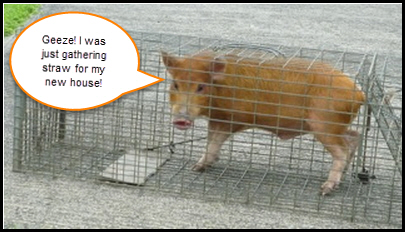
by Lorraine Brodek | May 13, 2014 | Blog
Baby pigs are nurtured in Hana because they grow up to be pua’a in the imu (big pig roasted in the under ground oven wrapped in banana leaves)–a big pig reason for a luau. But the Maui gardener wants them to stay in the jungle.
 One of the first hints that you might have a wild (feral) pig problem is poop. This seems to be the subject of a number of my ruminations recently. Ruminate is an appropriate word here because that’s what pigs do when they start chomping on the grubs, macadamia nuts, papaya and potatoes they find by rooting under vines and trees. Paradise isn’t always pretty because there’s a lot of free range everything. And no one makes it their mission to follow every pooping thing around with little plastic bags in hand and then deposit these collections in the green can. There are no green cans here. The natural jungle is our green can.
One of the first hints that you might have a wild (feral) pig problem is poop. This seems to be the subject of a number of my ruminations recently. Ruminate is an appropriate word here because that’s what pigs do when they start chomping on the grubs, macadamia nuts, papaya and potatoes they find by rooting under vines and trees. Paradise isn’t always pretty because there’s a lot of free range everything. And no one makes it their mission to follow every pooping thing around with little plastic bags in hand and then deposit these collections in the green can. There are no green cans here. The natural jungle is our green can.
So it was like a pig rerun or piggy-back (so to say) for me yesterday. The last chapter in my book, A Nobody in a Somebody World, is titled “Sows and Tsunamis in Hulawood.” One of my favorite things to do is to hop on my John Deere riding mower and cut grass. Better than therapy. I wrote how I was zipping around the bend near the neighboring jungle brush and guava trees when all of a sudden from behind the Tahitian lime tree I was confronted by a huge reddish brown wild sow with an amazing likeness to Don Rickles.
 She firmly planted her hooves into the ground in front of me, started with major snorting and oinking, and began her charge. No one, but no one, was going to put a scratch or a dent in my John Deere. So I revved it up into high gear, went eyeball-to-eyeball with my gnarly attacker, thrust my green machine into forward, and threw a lemon at her that I had saved in my cup holder. She backed off, but at that very second eight piglets came scurrying out from under the ferns and Pikake vines, all squealing and running amuck every which way.
She firmly planted her hooves into the ground in front of me, started with major snorting and oinking, and began her charge. No one, but no one, was going to put a scratch or a dent in my John Deere. So I revved it up into high gear, went eyeball-to-eyeball with my gnarly attacker, thrust my green machine into forward, and threw a lemon at her that I had saved in my cup holder. She backed off, but at that very second eight piglets came scurrying out from under the ferns and Pikake vines, all squealing and running amuck every which way.
I started screaming in my most threatening of voices, “Waho! Waho! (Out! Out!)” I figured it was best to give a shout-out in Hawaiian since they were local pigs. Tom heard this commotion and came zooming over in the Polaris Ranger. Within seconds, the boar appeared, all black, huge with tusks bigger than a mastodon’s. Tom grabbed his air horn, which is his favorite farming intercom device, and blasted away. It was now pig pandemonium, or in Hawaiian Pidgin-speak, everyting buckaloose (out of control). A few more blasts from the air horn and the porkers retreated. The pigs were trying to reclaim their territory in what is now our space and my garden.
 The tell-tail sign that it was “piggy-back” Monday was the black poop (and/or scat) all over “my” freshly mowed lawn. This discovery was at day’s end, so we didn’t implement Plan-A by calling our local pig hunters. We saved that assignment for the next day. We went to bed dreaming of spareribs. And then..awakened abruptly this morning by the shrill, loud, piercing squeal of a piglet. Obviously, instead of a ripe papaya on the ground, this little one was enticed by a yogurt container of Kashi Go Lean (crunchy cereal) that Tom had placed in the Have-A-Heart trap. He had set it the night before to catch a mongoose (looks like it’s distant ferret cousin) that had taken up residence in our lava wall.
The tell-tail sign that it was “piggy-back” Monday was the black poop (and/or scat) all over “my” freshly mowed lawn. This discovery was at day’s end, so we didn’t implement Plan-A by calling our local pig hunters. We saved that assignment for the next day. We went to bed dreaming of spareribs. And then..awakened abruptly this morning by the shrill, loud, piercing squeal of a piglet. Obviously, instead of a ripe papaya on the ground, this little one was enticed by a yogurt container of Kashi Go Lean (crunchy cereal) that Tom had placed in the Have-A-Heart trap. He had set it the night before to catch a mongoose (looks like it’s distant ferret cousin) that had taken up residence in our lava wall.
 We are usually a catch and release family. Our daughters would never forgive us if we conked this piglet on the head and used her for bacon. Miss Piggy, Babe, Porky and Sarah Palin have cured my urge to hunt and gather. Not to mention that cute Geico piggy. This now captured and caged little swine relative had definitely put on a few pounds–about 40 of ’em. Tom grunted as he lifted Babe into the back of the Ranger. I could hear her squealing as she and he drove off through the jungle together and down to the oceanfront pasture land where she can roam free and poop as much as she wants along with the cows and bulls and mongoose and chickens and pheasants. No wonder everything is so green down there in that pasture. Who needs a green can.
We are usually a catch and release family. Our daughters would never forgive us if we conked this piglet on the head and used her for bacon. Miss Piggy, Babe, Porky and Sarah Palin have cured my urge to hunt and gather. Not to mention that cute Geico piggy. This now captured and caged little swine relative had definitely put on a few pounds–about 40 of ’em. Tom grunted as he lifted Babe into the back of the Ranger. I could hear her squealing as she and he drove off through the jungle together and down to the oceanfront pasture land where she can roam free and poop as much as she wants along with the cows and bulls and mongoose and chickens and pheasants. No wonder everything is so green down there in that pasture. Who needs a green can.
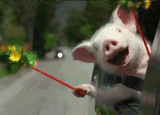
Hope your day is as happy as ours in Porkers’ Paradise!
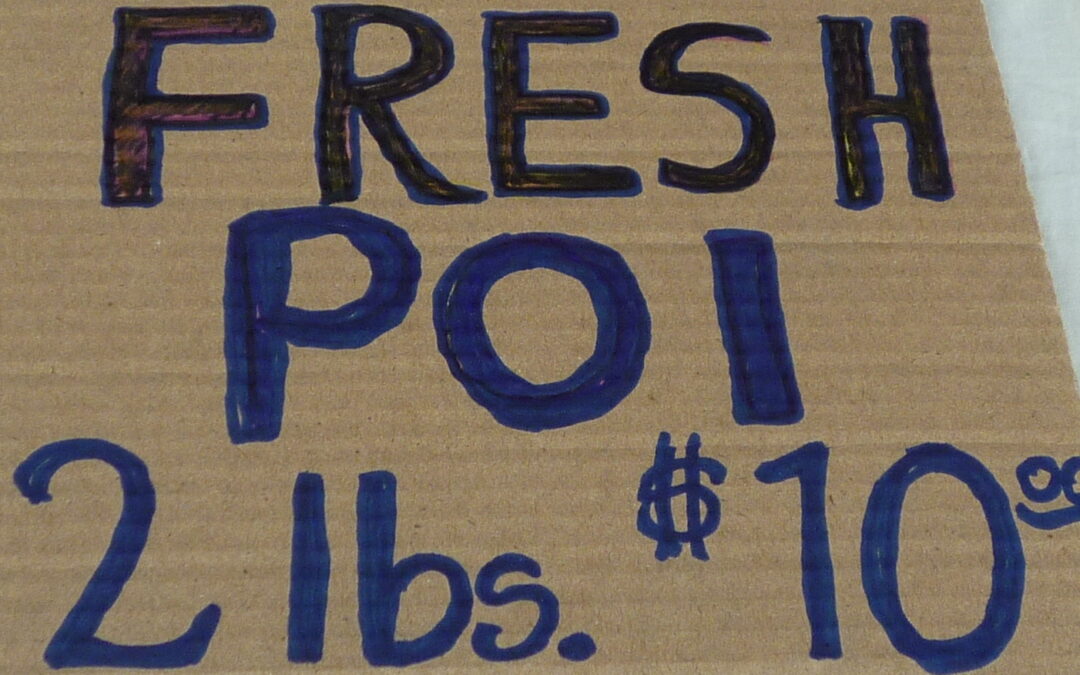
by Lorraine Brodek | May 7, 2014 | Blog
Poi seems to be the #1 traditional food of almost all Hawaiians and is considered to be “the staff of life” on the islands–with beer running a close second.
 If you’ve never had the opportunity to sample poi, I am here to provide a bit of history on how this finger-food originated. It is made from Taro (or kalo) which is a broad-leafed plant that loves its feet wet and prefers eastern Maui. The East Maui Taro Festival was held in Hana this past weekend and Boy! (rhymes with poi) did I learn a lot. First off, poi is serious business in Hawaii and is a main ingredient in their culture. Legends abound here and Hawaiians take them to heart. Make a fist with your right hand and pound it just above your heart and smile. It seems that the first Hawaiian was a guy named Haloa. Mythology claims that his spirit came from the Taro plant as did all the natives themselves. But that did not necessarily make them vegetarians because they also love cooked pig and Spam. When poi is served with the meal, you’d better not be arguing or talking about Auntie Peni or Uncle Wene in a mean way. You’d better be thinking happy thoughts. Thus the Taro Festival is a celebration of the Hawaiian culture bringing the young and old and uninformed and hungry together all in one ballpark.
If you’ve never had the opportunity to sample poi, I am here to provide a bit of history on how this finger-food originated. It is made from Taro (or kalo) which is a broad-leafed plant that loves its feet wet and prefers eastern Maui. The East Maui Taro Festival was held in Hana this past weekend and Boy! (rhymes with poi) did I learn a lot. First off, poi is serious business in Hawaii and is a main ingredient in their culture. Legends abound here and Hawaiians take them to heart. Make a fist with your right hand and pound it just above your heart and smile. It seems that the first Hawaiian was a guy named Haloa. Mythology claims that his spirit came from the Taro plant as did all the natives themselves. But that did not necessarily make them vegetarians because they also love cooked pig and Spam. When poi is served with the meal, you’d better not be arguing or talking about Auntie Peni or Uncle Wene in a mean way. You’d better be thinking happy thoughts. Thus the Taro Festival is a celebration of the Hawaiian culture bringing the young and old and uninformed and hungry together all in one ballpark.
 We mainlanders (those coming from the continental U.S.) think the definition of “poi” is: “No taste” and/or “Paste.” I need to bring Dave Barry into the discussion here. I just love Dave Barry and his Christopher Robin haircut. But to spare him embarrassment, we’ve never met. However, in his new hilarious book, he talks about hominy and how it sounds like a disease. Now the reason I bring this up is that to me poi is in the same food group as hominy. Another food that should be in there is grits. Husband Tom’s mother came from Alabama where grits is revered. Now it just seems to me that “yes” these names do conjure up illness. Like..”I don’t feel like standing here and talking now, I’ve got the grits.” or “I should have gotten my vaccination at WalMart. I think I’ve caught Poi.” In this case, it does not mean Penguins on Ice.
We mainlanders (those coming from the continental U.S.) think the definition of “poi” is: “No taste” and/or “Paste.” I need to bring Dave Barry into the discussion here. I just love Dave Barry and his Christopher Robin haircut. But to spare him embarrassment, we’ve never met. However, in his new hilarious book, he talks about hominy and how it sounds like a disease. Now the reason I bring this up is that to me poi is in the same food group as hominy. Another food that should be in there is grits. Husband Tom’s mother came from Alabama where grits is revered. Now it just seems to me that “yes” these names do conjure up illness. Like..”I don’t feel like standing here and talking now, I’ve got the grits.” or “I should have gotten my vaccination at WalMart. I think I’ve caught Poi.” In this case, it does not mean Penguins on Ice.
 So I know while you’re reading this that you can hardly stand the wait any longer..how is poi made? I don’t think you’re going to find these culinary tools at Williams Sonoma. First, you’re going to need a poi pounder. The stone material for a pounder is basalt. When you Google this word, you’re going to see big words like aphanitic igneous, feldspathoid, plagioclase. Somehow, I don’t think the ancient Hawaiians cared about any of this geology mumbo-jumbo. They just used lava rocks. Then they sculpted them into knobbed pounders which look like the shape of 1/2 of a bull’s testicles (please see my blog on “Pasture Golf”). Apologies for this graphic description, but a lot in the Hawaiian culture can be phallic or has sexual overtones..as in their hula, their chants and their pounders. That’s why we mainlanders love going to a luau, but we usually pass on the poi.
So I know while you’re reading this that you can hardly stand the wait any longer..how is poi made? I don’t think you’re going to find these culinary tools at Williams Sonoma. First, you’re going to need a poi pounder. The stone material for a pounder is basalt. When you Google this word, you’re going to see big words like aphanitic igneous, feldspathoid, plagioclase. Somehow, I don’t think the ancient Hawaiians cared about any of this geology mumbo-jumbo. They just used lava rocks. Then they sculpted them into knobbed pounders which look like the shape of 1/2 of a bull’s testicles (please see my blog on “Pasture Golf”). Apologies for this graphic description, but a lot in the Hawaiian culture can be phallic or has sexual overtones..as in their hula, their chants and their pounders. That’s why we mainlanders love going to a luau, but we usually pass on the poi.
The next thing you’re going to need is something to pound your poi on. It’s usually a hand-carved board made out of the wood of a Milo tree or Kou tree (which is also a great wood for making canoes). Were these guys major hunters and gatherers or what..bare-footin’ it while chanting their way through the jungle, in their string Speedo loin cloths and carrying out trees the size of canoes and chunks of lava for pounders? Wow! And we complain when we have to walk 1/2 mile pushing a shopping cart loaded with a year’s worth of food in the CostCo parking lot.
 You always have to wonder who was the first guy to say, “Hey! Let’s dig up that plant over there with the big leaves.” Then..”Oh! Look at that dirty hunk of something underneath. I have an idea. Let’s cook it and eat it.” I would not be that person. But thank goodness those kinds of people were out there running around and foraging and discovering potatoes, peanuts, carrots, beets and all manner of dirt-covered edible underground stuff.
You always have to wonder who was the first guy to say, “Hey! Let’s dig up that plant over there with the big leaves.” Then..”Oh! Look at that dirty hunk of something underneath. I have an idea. Let’s cook it and eat it.” I would not be that person. But thank goodness those kinds of people were out there running around and foraging and discovering potatoes, peanuts, carrots, beets and all manner of dirt-covered edible underground stuff.
 So get in there and dig up that big Taro tuber and steam it (traditionally in an underground oven–Hawaiians love cooking underground). Then you find a sharp seashell (preferably opihi) and peel the root, cut it into chunks and put it on the carved wooden Milo board.
So get in there and dig up that big Taro tuber and steam it (traditionally in an underground oven–Hawaiians love cooking underground). Then you find a sharp seashell (preferably opihi) and peel the root, cut it into chunks and put it on the carved wooden Milo board.
This is where a bit of energy and musical rhythm comes in..thump, whump, slap. Grab your pounder and start kneading and smooshing the root with an occasional pause to dip your fingers into a nearby wooden water bowl and sprinkle some water on the taro so it won’t get too sticky. This also controls the consistency. Not one pair of plastic gloves did I see worn by the poi makers at the festival. I just had to have faith and believe that the pounder’s hands had been where they should have been.
 After about ten minutes of whacking and whumping, poi was created. I have never been one to spark to gray food, but that was the color of the gooey mass that resulted. Plus it really did look like a pile of what you find in a cow pasture. So I had to channel my inner “yum” and forget what it looked like. And then I had to be careful how I ate it. How to eat poi: dip and lick..only with your fingers. Use just two of them..preferably the index and middle finger. Don’t use three–that’s gluttonous.
After about ten minutes of whacking and whumping, poi was created. I have never been one to spark to gray food, but that was the color of the gooey mass that resulted. Plus it really did look like a pile of what you find in a cow pasture. So I had to channel my inner “yum” and forget what it looked like. And then I had to be careful how I ate it. How to eat poi: dip and lick..only with your fingers. Use just two of them..preferably the index and middle finger. Don’t use three–that’s gluttonous.
My final suggestion is that you follow up your finger-lickin’ poi with a swig of beer. Then you can pour a little on your fingers and lick that, too.
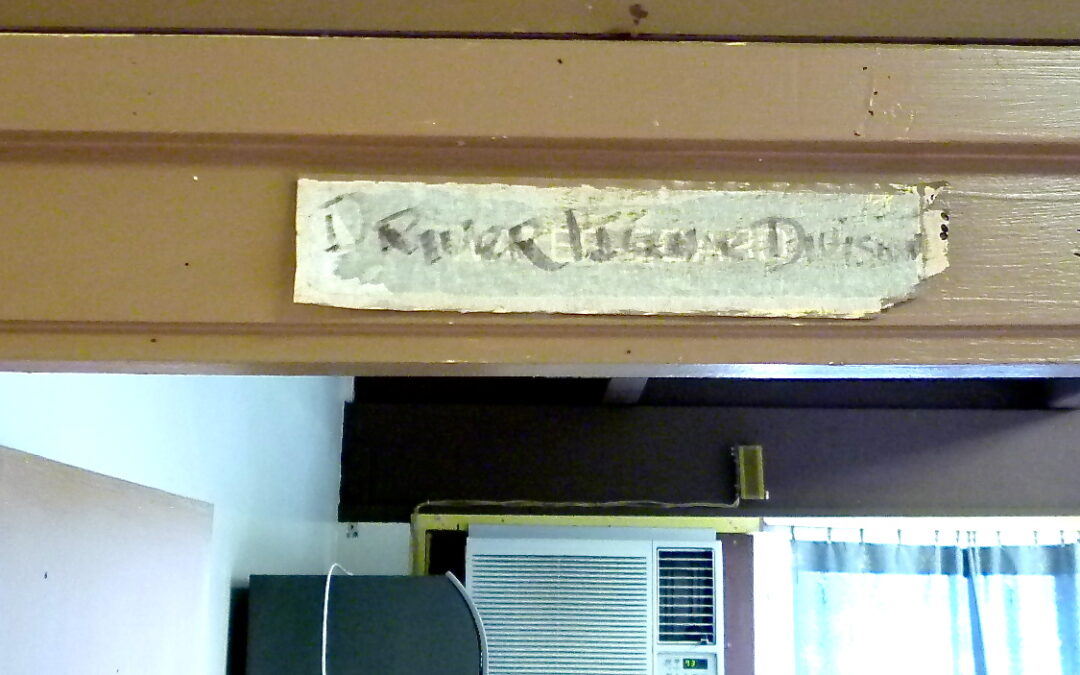
by Lorraine Brodek | Apr 30, 2014 | Blog
 The tattered, barely readable words in black ink written on top of another illegible sign is scotch-taped above the multi-painted brown door. “Driver License Division” announces that you are at the right place. An old school-house desk sits just outside the open door revealing a closet-sized office and the happy, smiling Hana “Driver License” lady, Leimomi (which means string of pearls in Hawaiian). “Next victim,” she giggles.
The tattered, barely readable words in black ink written on top of another illegible sign is scotch-taped above the multi-painted brown door. “Driver License Division” announces that you are at the right place. An old school-house desk sits just outside the open door revealing a closet-sized office and the happy, smiling Hana “Driver License” lady, Leimomi (which means string of pearls in Hawaiian). “Next victim,” she giggles.
Resident drivers in the state of Hawaii are required to take a written test. Yes. Hawaii is the 50th state and it actually uses American currency and has the same governmental rules and regs. Just don’t think that because you move to Maui that you can drive your Woody, wave wagon or 4-Runner around with a California “Dreamin” driver’s license in your wet suit. You’d be dreamin’.
So as a public service, I’m going to provide a brief tutorial. I visited the internet “Home Page” from the Hawaiian Dept. of Transportation. They tell me that I can study all of the 171 practice test questions. Now..first off..what’s with the 171? Why can’t it be an even number like 180 divisible by 30=6 tests. If you divide 171 by 30, you get 5.7 tests to practice on and that means you’re short-changed on one of them and dontcha know those will be the very questions showing up on your “for real, fail or go to jail” test. Couldn’t they think of 9 other questions? Or less? 171 is a lot of questions. Oh wait..the Home Page says that it’s providing 12 different tests for me to practice on. All-righty then–just make it 168 questions divided equally makes 14 tests to practice on. Geez! Now for the final warning: “You can only miss 5 questions.” 5 questions?! How about 6 questions–a 20% flub-rate would be a normal ‘B’ grade–right? Okay, so here goes:
 Instructions: “All questions are multiple-choice. Each answer in this interactive test have explanations why something is right or wrong.” (That sentence needs a grammatical touch-up.) And I don’t need an explanation if I get the answer right for heaven’s sake–I get it. “Therefore you will be learning as you take the test. Good luck.” Of course, they wish me good luck because then I’ll write a check to the Dept. of Finance for $22.
Instructions: “All questions are multiple-choice. Each answer in this interactive test have explanations why something is right or wrong.” (That sentence needs a grammatical touch-up.) And I don’t need an explanation if I get the answer right for heaven’s sake–I get it. “Therefore you will be learning as you take the test. Good luck.” Of course, they wish me good luck because then I’ll write a check to the Dept. of Finance for $22.
Now here are the for-real, I’m not kidding, honest-to-God questions. The only answer that’s not for real is #5 (that’s my obvious suggested answer). Let’s get started:
#14. The boss chews you out just before quitting time. You don’t say much, but You think he is unfair and You are angry! When You get to your car you should:
1. Play the radio loud, so You won’t think about it.
2. Drive fast on the Interstate so You can let off steam.
3. Take a few minutes to cool off before You drive home.
4. Stop in your favorite bar and have a few drinks before driving home.
5. Start looking for another job.
P.S. The state’s “comments” says: “Better to be ‘cooled off’ as a live person than to be a ‘cold’ dead body in a morgue.
#43. Certain highway signs and markings require that you must obey the indicated instruction. Such signs are known as:
1. Regulatory signs.
2. Information signs.
3. Warning signs.
4. Guide signs.
5. Who the heck cares what kind of sign it is. If the sign says “Stop,” Stop! Just obey it already.
#51. Edgelines are solid____or____lines along the edges of the roadway to be used as a safety quide to mark the limits of the traveled way.
1. Yellow; white
2. Orange; white
3. Red; white
4. Green; white
5. They could be bright blue;white for all we care. Just don’t drive over the edge and off the cliff.
#71: Pedestrian signals consist of the lighted words “WALK” and “DON’T” WALK” and the symbols of a walking person and an upraised palm. A steady “DON’T WALK” or upraised palm signal means:
1. Pedestrians must not enter the roadway toward the signal.
2. Pedestrians already in the intersection facing the signal may continue to the nearest sidewalk, traffic island or safety zone.
3. Pedestrians already in the intersection facing the signal must RUN to the nearest sidewalk.
4. Both 1 and 2 above.
5. It says “DON’T WALK”! If you can’t read that, you probably need to enroll in a state literacy class.
#88. A few drinks after work before driving home:
1. Is good because you miss the rush hour traffic.
2. Is good because they help to release the day’s tension and make you a safer driver.
3. Should be avoided because they may make you a dangerous driver.
4. Never hurt anyone.
5. Is good because it’s answer #4 in question #14.
#94: Drugs may interfere with a person’s ability to drive safely:
1. Only if the drugs are prescribed by a doctor.
2. Only when taken while drinking.
3. Only when driving at night.
4. And it is important to ask your doctor about any effects that the prescribed drugs may have on your driving ability.
5. And it is important to ask your doctor if he drinks and takes drugs.
#96. The effect that alcohol has on your reflexes and judgment:
1. Is less if you were only drinking beer.
2. Is less if you were only drinking wine.
3. Is greater if you were drinking whiskey or hard liquor.
4. Depends on the amount of alcohol in your blood stream.
5. Is less if you drive home really fast before the alcohol has a chance to take effect.

#103. You are driving behind another vehicle. You notice that the driver is driving with one hand, talking to a passenger. You as a driver:
1. Know that you should give the vehicle ahead extra room.
2. Know that the driver in the vehicle ahead is reducing his safety margin by being an inattentive driver.
3. Know the you should avoid this bad habit.
4. All of the above.
5. Know that the driver could be an amputee and is missing a hand.
#105. An arrogant driver is a driver who:
1. Is purposely in a hurry, competing with other traffic,
2. Shows little or no respect for traffic laws, or the way of others.
3. You should try to avoid when driving.
4. All of the above.
5. Drives a Lamborghini Aventador or a Ferrari F12berlinetta or a Hummer H1.
#137. You wish to exit the freeway, but have missed your exit ramp. You should:
1. Back up on the shoulder to get onto your exit ramp.
2. Turn around on the shoulder and drive on the shoulder to your exit.
3. Cut across the grass to your exit.
4. Continue driving to your next exit.
5. Say “Oh #*%#!” because you know your next exit is ten #*%#ing more miles down the road.
#148. You are driving down a hill and notice a heavy vehicle fast approaching from behind. You should:
1. Pay no attention as heavy vehicles always speed down hills.
2. Know that you have the right of way and it is the truck driver’s responsibility to miss you.
3. Know that you may have to move out of the heavy vehicle’s way.
4. Drive on the right side of the highway and slow down.
5. Be grateful you’re not on the Los Angeles’ #405 or you’ll be dead.
#149. When passing a large vehicle a driver of a small vehicle must be prepared for:
1. A loud noise.
2. Excess air pollution.
3. Wind gusts produced by the large vehicle.
4. Falling vehicle parts.
5. Overflowing cement or roofing tar, flying asphalt or possible oil tanker explosion.
Now these sample questions above are just a dozen out of the 171. The good news is that I only missed one answer out of 30 for a .033333% error rate. And what is the question that I flubbed, you might ask. Here it is:
 #44. Certain highway signs and markings contain information about hazardous conditions. Such signs are known as:
#44. Certain highway signs and markings contain information about hazardous conditions. Such signs are known as:
1. Regulatory signs.
2. Information signs.
3. Warning signs.
4. Guide signs.
Isn’t this the same question as #43? Not quite. Well, question #44 says that the signs contain information, so I put an “X” on answer #2. Wrong! Do not pass “Go.” It’s answer #3. So I’m here to warn you. Be sure to study up before taking your driving test in the ‘Aloha State.’ The friendliest thing about my DT experience was Leimomi, the Hana “Driver License” lady. You’re going to love her laugh (when you get a wrong answer) and her hours are posted.
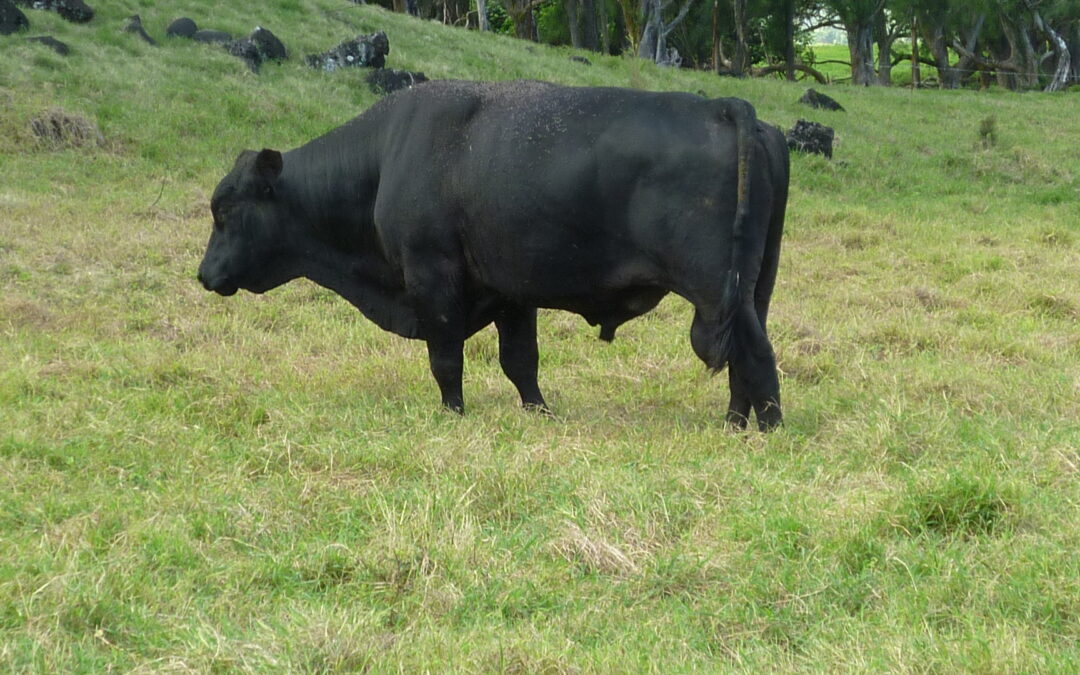
by Lorraine Brodek | Apr 15, 2014 | Blog
 The great thing about living where your mind can wander and your body roam free, is that you can come up with stupid/fun ideas that are still legal and you’re not institutionalized. Such is Pasture Golf..but this game could ONLY have been created by the male of the species. In Hana, it’s called being a member of the PGA. It’s a private, invitation-only, immature boys (that’s redundant) club. It requires a minimal degree of skill–trust me on this–dress code optional, a fast pair of legs and a lot of balls. As in two bags full. Also two rusty clubs–no Big Berthas allowed because of Hazard #4: lava rocks. A guy can jam his elbow right up into his rotator cuff due to the reverberation factor if his club hits hard rock instead of softer ball. BOING-nG-nG-G! OW!
The great thing about living where your mind can wander and your body roam free, is that you can come up with stupid/fun ideas that are still legal and you’re not institutionalized. Such is Pasture Golf..but this game could ONLY have been created by the male of the species. In Hana, it’s called being a member of the PGA. It’s a private, invitation-only, immature boys (that’s redundant) club. It requires a minimal degree of skill–trust me on this–dress code optional, a fast pair of legs and a lot of balls. As in two bags full. Also two rusty clubs–no Big Berthas allowed because of Hazard #4: lava rocks. A guy can jam his elbow right up into his rotator cuff due to the reverberation factor if his club hits hard rock instead of softer ball. BOING-nG-nG-G! OW!
 All the guys have nicknames to protect their identity. I’ll give you Tom’s: it’s BLT..not the sandwich..but as in “Big Little Tommy.” Don’t ask, don’t tell. So the PGA goes something like this: BLT goes down to the pasture to join Pinky, Pa, The Rabbi, Whitey, Crash, MacCheezy, RockyRolly..or whosoever might be playing that day. Bubba and Tiger are not members. The group is held to no more than seven or eight because it can get unruly and takes too long to play the course. Everyone wants to get back to the broken tail gate to “wine-toast” the winner, followed by the chest-bump-high-five-grunt-grunt ritual. The winner is the guy who loses the most balls. On average, the minimum ball loss is: two balls per hole.
All the guys have nicknames to protect their identity. I’ll give you Tom’s: it’s BLT..not the sandwich..but as in “Big Little Tommy.” Don’t ask, don’t tell. So the PGA goes something like this: BLT goes down to the pasture to join Pinky, Pa, The Rabbi, Whitey, Crash, MacCheezy, RockyRolly..or whosoever might be playing that day. Bubba and Tiger are not members. The group is held to no more than seven or eight because it can get unruly and takes too long to play the course. Everyone wants to get back to the broken tail gate to “wine-toast” the winner, followed by the chest-bump-high-five-grunt-grunt ritual. The winner is the guy who loses the most balls. On average, the minimum ball loss is: two balls per hole.

Oh…did I mention this is a bull pasture. Hazard #1: Black bulls, brown bulls, mean geezer bulls, young, horny bulls. This is the “stupid” part in the whole PGA idea. There’s no fixing stupid. And..oh..#2: there’s a water hazard–like almost the entire eastern shore of the Pacific ocean. It washes and sprays against the lava cliffs just below the pasture with the golfers and a lot of bulls. Or maybe it should be the pasture and golfers with a lot of bull. Winds can be Hazard #3: trade winds, high velocity Kona winds (emanating from the big island of Hawaii) or breezes zipping down from the Haleakala (Holly-ah-ka-la) volcano which is dormant. This means it hasn’t erupted since 1790, but that could be hear-say because who’s here now to say otherwise?

The pasture is a four- can/cup course–give or take a rusted water trough or coconut pile. Speaking of piles, if your ball lands in a cow pie (and/or bull cake), it’s a hole-in-one. The first hole is a big red cup on a stick. The second hole is a Bud (weizer..not “Lite”) can on a stick. The third hole is a Coors can on a stick..and so it goes. The cans/cups have to be empty, so that means drinking is involved. I bet you’re shocked. If you hit an egret, it’s a birdie. If you hit a bull, it’s a double bogie. That’s where the fast legs come in. It’s also a way to keep a running turnover in membership, so some other non-thinker-drinkers can join. The term “golf widow” comes to mind here.
It was a good PGA day this week. BLT arrived back home without injury, got his handicap down to a 25, but I made him take his boots off in the driveway. It had rained the night before in the pasture making all the pies and cakes soggy. He was really happy because they got to play two rounds of the four-can course with ONLY one cowitus interruptus. He also won the bottle of wine because he was the last man standing with no balls.

 Since I’m thrilled to have one friend who actually reads my stuff, I’m more than happy to oblige. So I opened up some of my iPhoto albums and, of course, the first flowers that caught my eye were orchids. Did you know that there are about 35,000 species of orchids in the world?! How many people did it take to count those things? I know for sure that we have a bunch of ’em at our house including some Cattleya and Phalaenopsis shown at right.
Since I’m thrilled to have one friend who actually reads my stuff, I’m more than happy to oblige. So I opened up some of my iPhoto albums and, of course, the first flowers that caught my eye were orchids. Did you know that there are about 35,000 species of orchids in the world?! How many people did it take to count those things? I know for sure that we have a bunch of ’em at our house including some Cattleya and Phalaenopsis shown at right. But here I am talking about poop again. I immediately emailed an orchid pic to Jil and lo and behold, it got her husband, George, all excited. He had just seen two amazing orchids on the internet and said I had to have them. He forwarded the photos my way and I couldn’t believe what I was seeing. I think they originate from Equador or Peru or somewhere down in those naked jungles, but I certainly believe they would be most happy growing on Maui. Of course, to get them here, we’d have to deal with the USDA, the IPPC, NAPPO, PHQG, the APHIS and PPQ programs, not to mention the EPA and the TSA. So perhaps a few pictures would do just as well.
But here I am talking about poop again. I immediately emailed an orchid pic to Jil and lo and behold, it got her husband, George, all excited. He had just seen two amazing orchids on the internet and said I had to have them. He forwarded the photos my way and I couldn’t believe what I was seeing. I think they originate from Equador or Peru or somewhere down in those naked jungles, but I certainly believe they would be most happy growing on Maui. Of course, to get them here, we’d have to deal with the USDA, the IPPC, NAPPO, PHQG, the APHIS and PPQ programs, not to mention the EPA and the TSA. So perhaps a few pictures would do just as well.


 She had grown naturally between these two branches. Poor thing I rescued her just in time. And she thanked me by blessing my Mai Tai that night:
She had grown naturally between these two branches. Poor thing I rescued her just in time. And she thanked me by blessing my Mai Tai that night:




























 The great thing about living where your mind can wander and your body roam free, is that you can come up with stupid/fun ideas that are still legal and you’re not institutionalized. Such is Pasture Golf..but this game could ONLY have been created by the male of the species. In Hana, it’s called being a member of the PGA. It’s a private, invitation-only, immature boys (that’s redundant) club. It requires a minimal degree of skill–trust me on this–dress code optional, a fast pair of legs and a lot of balls. As in two bags full. Also two rusty clubs–no Big Berthas allowed because of Hazard #4: lava rocks. A guy can jam his elbow right up into his rotator cuff due to the reverberation factor if his club hits hard rock instead of softer ball. BOING-nG-nG-G! OW!
The great thing about living where your mind can wander and your body roam free, is that you can come up with stupid/fun ideas that are still legal and you’re not institutionalized. Such is Pasture Golf..but this game could ONLY have been created by the male of the species. In Hana, it’s called being a member of the PGA. It’s a private, invitation-only, immature boys (that’s redundant) club. It requires a minimal degree of skill–trust me on this–dress code optional, a fast pair of legs and a lot of balls. As in two bags full. Also two rusty clubs–no Big Berthas allowed because of Hazard #4: lava rocks. A guy can jam his elbow right up into his rotator cuff due to the reverberation factor if his club hits hard rock instead of softer ball. BOING-nG-nG-G! OW!



 Lorraine is a former needlecraft designer who formed her own company (Fingerworks, Inc.)
during the 1970’s and 80’s. With this marketing experience, she ventured back into her chosen
field of film and television and rose up the ranks as an executive with Warner Bros. (Time-Warner). She is also a landscaping professional, author, humorist and artist. She has published four books: “The Tale of Peeky Peeper” (a fun children’s rhyming Holiday book, which she also illustrated); followed by her humorous memoir, “A Nobody in a Somebody World: My Hollywood Life in Beverly Hills.” Playfulness is the theme in whatever she does, as you’ll see in the two versions of her puzzle-like charted coloring books: “Griddles.” When she’s not creating something, you’ll find this 82 year-old grandma whacking a Pickle Ball, teaching movie
history, testing new recipes on her husband, Tom, or serving on the board of the Del Webb Performing Arts Center in Wickenburg, AZ.
Lorraine is a former needlecraft designer who formed her own company (Fingerworks, Inc.)
during the 1970’s and 80’s. With this marketing experience, she ventured back into her chosen
field of film and television and rose up the ranks as an executive with Warner Bros. (Time-Warner). She is also a landscaping professional, author, humorist and artist. She has published four books: “The Tale of Peeky Peeper” (a fun children’s rhyming Holiday book, which she also illustrated); followed by her humorous memoir, “A Nobody in a Somebody World: My Hollywood Life in Beverly Hills.” Playfulness is the theme in whatever she does, as you’ll see in the two versions of her puzzle-like charted coloring books: “Griddles.” When she’s not creating something, you’ll find this 82 year-old grandma whacking a Pickle Ball, teaching movie
history, testing new recipes on her husband, Tom, or serving on the board of the Del Webb Performing Arts Center in Wickenburg, AZ.